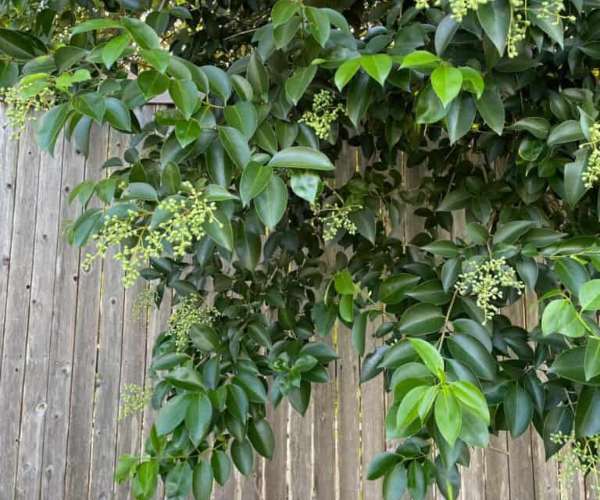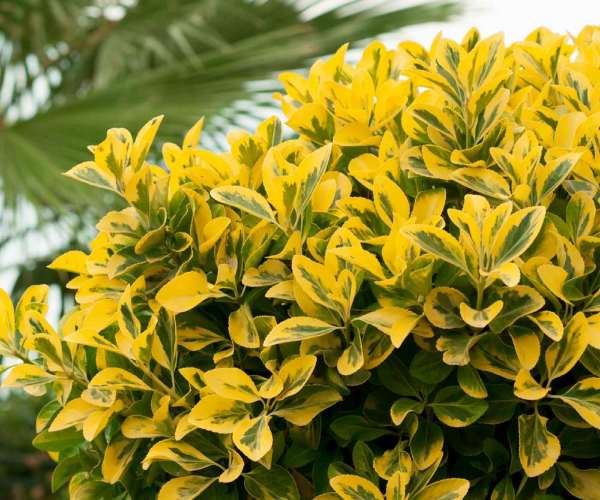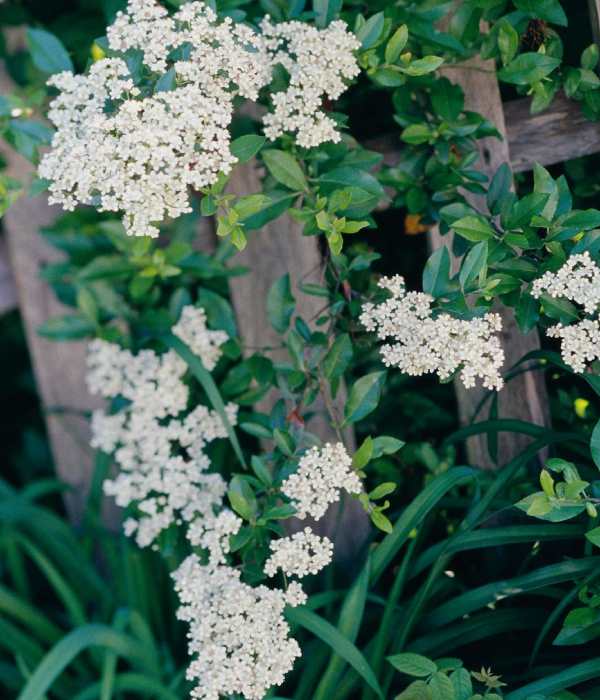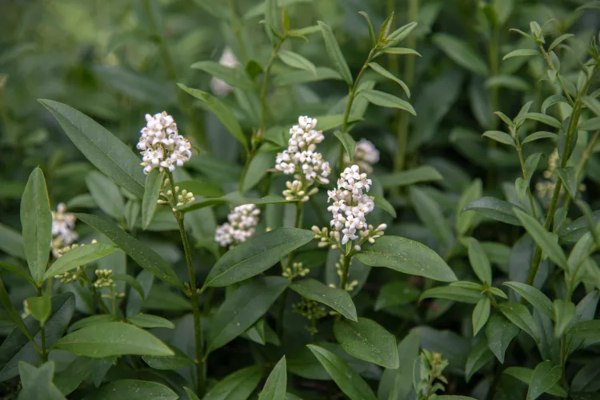Privet plants or Ligustrum spp. are flowering evergreen shrubs and are commonly called known as hedges. They can also be grown as small, bushy trees, depending on the specific variety. These famous plants roughly have 50 varieties in the Ligustrum genes that give a beautiful and classic look when they run along your home border. Privets’ names even say privacy and they provide privacy by forming a natural privacy fence for those who seek a secluded setting in their yard.
While it can look great running along a property border, many of its other species are not especially ornamental. They are either evergreen or deciduous meaning they drop leaves over winter, and have thick, oval-shaped glossy green leaves. Some varieties have different leaf shades.
Talking about blooms, small, tubular structured flowers bloom on panicles during early summer. They bear a strong fragrance that some people dislike. The blooms are followed by round, black fruit clusters. These plants grow quickly and can be planted in the spring or fall.
One thing you need to know is that the fruits and leaves of privets are toxic to pets and humans too.

- Common Name: Privet Plants
- Botanical Name: Ligustrum spp.
- Family: Oleaceae
- Plant Type: Shrub
- Mature Size: 4–15 ft. tall, 4–10 ft. wide
- Sun Exposure: Full, partial
- Soil Type: Well-drained
- Soil pH: Acidic, neutral, alkaline
- Bloom Time: Summer
- Flower Color: White
- Hardiness Zone: 3–8 (USDA)
- Native Area: Asia, Africa, Europe
- Toxicity: Toxic to animals and humans
Also, Read Container Gardening Made Easy: 10 Sun and Shade-Loving Low-Maintenance Plants
Privet plants care
Privet plants are very easy to care for and can tolerate many growing conditions. However, you have to ensure that they are getting a good plantation site with good drainage. Also, some privets are known to be invasive plants, depending on your place. Before planting privets, make sure the species you plan to have is preferable for your area.

To plant a new hedge, put the privets almost a foot apart in a trench that is 2 feet wide and 2 feet deep. Then, mound the soil around the stems. It is essential to water new privets regularly and the old ones during dry seasons. Fertilizing your plants throughout their growing season, spring to fall is also beneficial. If you’re planning to grow them in containers, it is not worth it because of their aggressive growth and size.
Light
These shrubs normally grow well in full sun, meaning they need at least six hours of direct sunlight almost every day. Sun will help the foliage to bring out its best color. They can also tolerate partial shade conditions.
Soil
As long as the soil has a good drainage, privets can tolerate a variety of soil types. They can also handle a soil pH from slightly acidic to slightly alkaline. However, they prefer a roughly neutral pH. These shrubs can also tolerate some salt in the soil. It makes them great options to be planted near roadways that get salted in winter or near ocean spray.

Water
Young privets love getting a deep weekly watering if they haven’t received any rainfall. The established ones have good drought tolerance but need water during a lengthy dry spell or during summers to prevent the soil from drying out completely.
Temperature and Humidity
In cooler climates, typically in the fall, privet shrubs shed leaves. This means they cannot provide year-long privacy as a hedge. Since there are many types, different species’ temperature requirements are different. The truth is they can survive temperatures below freezing as well as the summer heat if they are watered properly.
While humidity isn’t that big of a problem, fungal diseases can grow on foliage that remains wet for a long and doesn’t have enough air circulation.
Fertilizer
You can use a 15-5-10 fertilizer or fertilizers made for broadleaf shrubs in the early spring. Apply another round of fertilizer in the fall.
Privet varieties
There are almost 50 species and even more varieties of privet plants. Some of them are:
Korean privet/California privet (Ligustrum ovalifolium): This variety of privets is hardy in zones 5 to 8 and it can grow up to 10 to 15 feet tall.
Golden privet (Ligustrum ovalifolium ‘Aureum‘): This variety features golden leaf margins and can grow up to 8 to 10 feet tall.

Common privet (Ligustrum vulgare): This species is known to tolerate cold and can form a fast-growing, dense hedge.
Border privet (Ligustrum obtusifolium): This species also has a good cold tolerance and can sometimes survive in the USDA zone 3.
Amur privet (Ligustrum amurense): This plant can also survive in USDA zone 3 and grows up to around 12 to 15 feet tall.
Pruning Privets
You can shape privets according to your wish and they won’t complain. They will quickly bounce back even after a heavy pruning. After it is done producing flowers for the season, it will start forming new buds for another year’s flowers.
If you want to see your hedge bloom in the coming year, pruning for its shape and size must be done as soon as that after flowering stops. A few light prunings during summers will encourage denser, bushier growth and produce more branches.
How to propagate Privets?
Gardeners often try to avoid privets since they grow vigorously. However, if you’re looking to propagate this classic plant, here is the way:
- When the spring arrives, take slim, pencil-thick cuttings that are about 6 inches in length. Don’t forget to remove all the leaves from the first 2 inches of the bottom half of the cuttings so the nodes can be seen.
- Dip the end of the cutting in the rooting hormone. Then, fill 4-inch plastic pots with potting mix. Using a stick, make a hole in the soil that is deep enough to fill the leafless portion of the cutting. Gently press the new cutting into the soil and water it properly until the soil is moist.

- Keep the pot in a bright location that gives indirect light, away from direct scorching shun. Remember to keep the cutting moist at all times. In a month or two, you will see new roots and also a new leaf growth.
- Finally, transplant to the landscape and keep it well moist for another month, water longer on hot days until new baby plants arrive.
Common Pests and Diseases
Privet plants can sometimes get leaf spots and powdery mildew, aphids, leaf miners, scale, mealybugs, and mites. However, that doesn’t affect the overall health of the plant. Some serious diseases include anthracnose and twig blight.
Some common privets problems
While Privets’ desirable property is its growth, the same thing can be a problem as well. Frequent pruning is necessary to keep a privet hedge manageable. While the growth rate of privets may vary, make sure to choose the one that won’t engulf your yard.
Privet hedges can also develop bare spots if the gardener doesn’t prune them properly.
FAQs
Q: How to know if privets are invasive?
A: Not all but some species such as Chinese privet (Ligustrum sinense) or Japanese privet (Ligustrum japonicum) are invasive when they are the only shrub growing in a location. They grow dense thickets that choke out all other native species.
Q: What can we plant as a hedge instead of a privets?
A: You can choose non-invasive options like Chinese privet or blackhaw viburnum that are native to North America.
Q: How much does a privet grow in a year?
A: When it gets sufficient water and nutrients, privet grows fast, 1 to 2 feet per year.
Also, Read Container Gardening Made Easy: 10 Sun and Shade-Loving Low-Maintenance Plants
